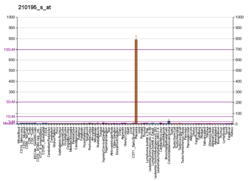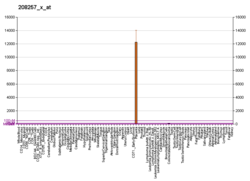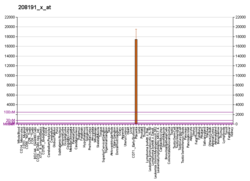| PSG1 | |||||||||||||||||||||||||||||||||||||||||||||||||||
|---|---|---|---|---|---|---|---|---|---|---|---|---|---|---|---|---|---|---|---|---|---|---|---|---|---|---|---|---|---|---|---|---|---|---|---|---|---|---|---|---|---|---|---|---|---|---|---|---|---|---|---|
| Identifiers | |||||||||||||||||||||||||||||||||||||||||||||||||||
| Aliases | PSG1, B1G1, CD66f, DHFRP2, FL-NCA-1/2, PBG1, PS-beta-C/D, PS-beta-G-1, PSBG-1, PSBG1, PSG95, PSGGA, PSGIIA, SP1, pregnancy specific beta-1-glycoprotein 1 | ||||||||||||||||||||||||||||||||||||||||||||||||||
| External IDs | OMIM: 176390; HomoloGene: 136364; GeneCards: PSG1; OMA:PSG1 - orthologs | ||||||||||||||||||||||||||||||||||||||||||||||||||
| |||||||||||||||||||||||||||||||||||||||||||||||||||
| |||||||||||||||||||||||||||||||||||||||||||||||||||
| |||||||||||||||||||||||||||||||||||||||||||||||||||
| |||||||||||||||||||||||||||||||||||||||||||||||||||
| Wikidata | |||||||||||||||||||||||||||||||||||||||||||||||||||
| |||||||||||||||||||||||||||||||||||||||||||||||||||
Pregnancy-specific beta-1-glycoprotein 1 (PSBG-1) also known as CD66f (Cluster of Differentiation 66f), is a protein that in humans is encoded by the PSG1 gene and is a member of the carcinoembryonic antigen (CEA) gene family. Pregnancy-specific glycoproteins (PSGs) are a complex consisting of carbohydrate and protein, which is present in the mammalian body specifically during pregnancy. This glycoprotein is the most abundant protein found in the maternal bloodstream during the later stages of pregnancy and it is of vital importance in fetal development. The PSG functions primarily as an immunomodulator to protect the growing fetus.
Structure
PSG is a member of the immunoglobulin (Ig) superfamily and contains four immunoglobulin domains.
The complete isolation of certain glycoproteins, later classified as pregnancy-specific, within human blood serum occurred in the early 1980s, when experimental techniques like molecular cloning became common practice. The serum was being collected during the first trimester of pregnancy to test for other vital molecules that are present during pregnancy and it was in those samples that they were able to isolate the PSGs specifically and characterize their structure. PSGs have been studied extensively in multiple mammalian species; mammals including rodents, monkeys, elk, moose, cows, sheep, and humans. Mice are the primary subject in significant portion of PSG studies. Specific structure can vary between species regarding different sugars within the carbohydrate and amino acids within the protein; all species that contain a glycoprotein will have a core protein covalently bound to a carbohydrate. This covalently bound complex structure greatly contributes to the stability of the PSG; mammalian PSGs have demonstrated continual activity when subjected to an environment from 20 to 60 °C and within a pH of 5.0-11.0. The protein portion of the PSG varies depending on the gene coding for it. Several of the genes and proteins have been characterized by common experimental methods such as polymerase chain reaction, gel electrophoresis, ELISA, and restriction enzymes. The different genes produce PSGs with varying masses that contain different exposed amino acids residues; the residues that are exposed determine the type of binding site that can be used to bind PSG.
While receptors for other PSG family members have been identified, the precise receptor for PSG1 remains unknown. Cell surface receptors for PSGs are found on many cells throughout the body including dendritic cells and epithelial cells. These receptors are present both during development and in the adult. These receptors are also similar between species. Studies comparing mice and human PSGs discovered that some human PSGs when inserted into mice demonstrated partial levels of activity, because receptors present on the mice cells were able to interact with the human PSG. PSGs require the presence of a proteoglycan (PG) on the surface of the cell in order to bind. The PSG actually will specifically bind to the glycosaminoglycan (GAG) portion of the PG, which protrudes from the membrane of the cell. Their binding of PSG can be affected by heparin, which is a competitive inhibitor that binds to the GAG portion of a PG.
Formation
Pregnancy-specific beta-1-glycoprotein is a major product of the syncytiotrophoblast in the placenta, reaching concentrations of 100 to 290 mg/L at term in the serum of pregnant women.
PSGs are synthesized through a gene's coding for a specific protein. These genes belong to a specific gene family; they are a subgroup of the carcinoembryonic antigen (CEA) family of genes. CEAs are immunoglobulins. Within humans there are total of 11 PSG genes located on the 19th chromosome; there are 17 genes within mice on the 7th chromosome. These genes code for PSGs that are of varying lengths of amino acids.
In order to characterize these separate types of PSGs, samples of the human placenta can be extracted and analyzed or they can be collected from blood. Though PSGs are abundant in the bloodstream a larger concentration is also found in the placenta, because PSGs are synthesized in the syncytiotrophoblast cells located in the placenta. Rodents also produce PSGs within their placenta but these cells are called spongiotrophoblasts. The presence of the PSGs can be recognized as early as 14 days after the initial fertilization of the egg. Throughout the course of the pregnancy the levels of PCGs within the bloodstream will continue to slowly and steadily rise.
Function
PSGs are extremely vital to development and health of a fetus. Specifically they are important in inducing, enhancing or inhibiting an immune response. PSGs regulate lymphocytes and without the presence of the PSGs the fetus would be susceptible to various types of immune attacks from the maternal bloodstream. This includes immune responses to things such as inflammation, infection, and trauma which may occur during pregnancy. In addition PSG presence within the maternal bloodstream can induce the secretion of growth factors affecting fetal growth. Low levels of PSGs in the maternal bloodstream are associated with higher occurrences of abortion, fetal retardation, low birth weight and hypoxia.
Inhibitors
Antibodies can form within the body that are specific to PSGs. These antibodies, when present, will cause symptoms similar as when PSG levels are low. Rodents and monkeys that were injected with a serum composed of the antibodies demonstrated an elevated abortion rate if pregnant and an increase of infertility if not pregnant. The receptors of some PSGs in mice have been discovered to be receptors for certain types of viruses. The mouse hepatitis virus (MHV) has been known to bind to a receptor for PSGs that is located within the brain.
External factors can also have an effect on the presence and function of PSGs. Specifically smoking during the first trimester of pregnancy can have adverse effects of the fetus. A pregnant female who has smoked is likely to have a significantly lower blood concentration of PSGs, specifically in the second and third trimester. The later effect on concentration correlates with restriction of fetal growth. A significant difference between the concentrations during the first trimester has not been conclusively proven.
Applications
A lack of PSGs can have such a detrimental effect on the success of a pregnancy that it is a standard practice to test and measure the levels of PSGs within the maternal bloodstream during the first trimester. A low concentration level of PSGs can be an indication of Down syndrome.
Though high levels of PSGs are ideal during fetal development; their concentration throughout the rest of life, excluding the times in which a female is pregnant, is ideally low. A low concentration in adults is wanted to ensure normal and effective responses from the immune system. Adults that have a high level of PSG within their system are significantly more likely to suffer from tumors, because the immune system is repressed from fighting of abnormal cell growth.
See also
References
- ^ GRCh38: Ensembl release 89: ENSG00000231924 – Ensembl, May 2017
- "Human PubMed Reference:". National Center for Biotechnology Information, U.S. National Library of Medicine.
- ^ "Entrez Gene: PSG1 pregnancy specific beta-1-glycoprotein 1".
- ^ McLellan AS, Fischer B, Dveksler G, Hori T, Wynne F, Ball M, Okumura K, Moore T, Zimmermann W (2005). "Structure and evolution of the mouse pregnancy-specific glycoprotein (Psg) gene locus". BMC Genomics. 6: 4. doi:10.1186/1471-2164-6-4. PMC 546212. PMID 15647114.
- ^ Gray-Owen SD, Blumberg RS (June 2006). "CEACAM1: contact-dependent control of immunity". Nat. Rev. Immunol. 6 (6): 433–46. doi:10.1038/nri1864. PMID 16724098. S2CID 34156579.
- ^ Lisboa FA, Warren J, Sulkowski G, Aparicio M, David G, Zudaire E, Dveksler GS (March 2011). "Pregnancy-specific glycoprotein 1 induces endothelial tubulogenesis through interaction with cell surface proteoglycans". J. Biol. Chem. 286 (9): 7577–86. doi:10.1074/jbc.M110.161810. PMC 3045012. PMID 21193412.
- ^ Watanabe S, Chou JY (February 1988). "Isolation and characterization of complementary DNAs encoding human pregnancy-specific beta 1-glycoprotein". J. Biol. Chem. 263 (4): 2049–54. doi:10.1016/S0021-9258(19)77983-6. PMID 3257488.
- Streydio C, Lacka K, Swillens S, Vassart G (July 1988). "The human pregnancy-specific beta 1-glycoprotein (PS beta G) and the carcinoembryonic antigen (CEA)-related proteins are members of the same multigene family". Biochem. Biophys. Res. Commun. 154 (1): 130–7. doi:10.1016/0006-291X(88)90660-2. PMID 3260773.
- ^ Hammarström S (April 1999). "The carcinoembryonic antigen (CEA) family: structures, suggested functions and expression in normal and malignant tissues". Seminars in Cancer Biology. 9 (2): 67–81. doi:10.1006/scbi.1998.0119. PMID 10202129.
- Huang F, Cockrell DC, Stephenson TR, Noyes JH, Sasser RG (October 1999). "Isolation, purification, and characterization of pregnancy-specific protein B from elk and moose placenta". Biol. Reprod. 61 (4): 1056–61. doi:10.1095/biolreprod61.4.1056. PMID 10491644.
- Waterhouse R, Ha C, Dveksler GS (January 2002). "Murine CD9 is the receptor for pregnancy-specific glycoprotein 17". J. Exp. Med. 195 (2): 277–82. doi:10.1084/jem.20011741. PMC 2193606. PMID 11805154.
- Horne CH, Towler CM, Pugh-Humphreys RG, Thomson AW, Bohn H (September 1976). "Pregnancy specific beta1-glycoprotein--a product of the syncytiotrophoblast". Experientia. 32 (9): 1197–1199. doi:10.1007/bf01927624. PMID 971765. S2CID 43539581.
- Motrán CC, Díaz FL, Gruppi A, Slavin D, Chatton B, Bocco JL (September 2002). "Human pregnancy-specific glycoprotein 1a (PSG1a) induces alternative activation in human and mouse monocytes and suppresses the accessory cell-dependent T cell proliferation" (PDF). J. Leukoc. Biol. 72 (3): 512–21. doi:10.1189/jlb.72.3.512. PMID 12223519. S2CID 11774170.
- Chen DS, Asanaka M, Yokomori K, Wang F, Hwang SB, Li HP, Lai MM (December 1995). "A pregnancy-specific glycoprotein is expressed in the brain and serves as a receptor for mouse hepatitis virus". Proc. Natl. Acad. Sci. U.S.A. 92 (26): 12095–9. Bibcode:1995PNAS...9212095C. doi:10.1073/pnas.92.26.12095. PMC 40303. PMID 8618851.
- ^ Pihl K, Christiansen M (March 2010). "Pregnancy-specific beta-1-glycoprotein in first-trimester maternal serum is influenced by smoking". Clin. Chem. 56 (3): 485–7. doi:10.1373/clinchem.2009.135970. PMID 19959618.
Further reading
- Khan WN, Teglund S, Bremer K, Hammarström S (1992). "The pregnancy-specific glycoprotein family of the immunoglobulin superfamily: identification of new members and estimation of family size". Genomics. 12 (4): 780–787. doi:10.1016/0888-7543(92)90309-G. PMID 1572651.
- Streydio C, Swillens S, Georges M, Szpirer C, Vassart G (April 1990). "Structure, evolution and chromosomal localization of the human pregnancy-specific beta 1 glycoprotein gene family". Genomics. 6 (4): 579–92. doi:10.1016/0888-7543(90)90492-D. PMID 2341148.
- Zheng QX, Tease LA, Shupert WL, Chan WY (March 1990). "Characterization of cDNAs of the human pregnancy-specific beta 1-glycoprotein family, a new subfamily of the immunoglobulin gene superfamily". Biochemistry. 29 (11): 2845–52. doi:10.1021/bi00463a030. PMID 2346748.
- Zoubir F, Khan WN, Hammarström S (May 1990). "Carcinoembryonic antigen gene family members in submandibular salivary gland: demonstration of pregnancy-specific glycoproteins by cDNA cloning". Biochem. Biophys. Res. Commun. 169 (1): 203–16. doi:10.1016/0006-291X(90)91455-2. PMID 2350345.
- Leslie KK, Watanabe S, Lei KJ, Chou DY, Plouzek CA, Deng HC, Torres J, Chou JY (August 1990). "Linkage of two human pregnancy-specific beta 1-glycoprotein genes: one is associated with hydatidiform mole". Proc. Natl. Acad. Sci. U.S.A. 87 (15): 5822–6. Bibcode:1990PNAS...87.5822L. doi:10.1073/pnas.87.15.5822. PMC 54420. PMID 2377620.
- Thompson JA, Mauch EM, Chen FS, Hinoda Y, Schrewe H, Berling B, Barnert S, von Kleist S, Shively JE, Zimmermann W (February 1989). "Analysis of the size of the carcinoembryonic antigen (CEA) gene family: isolation and sequencing of N-terminal domain exons". Biochem. Biophys. Res. Commun. 158 (3): 996–1004. CiteSeerX 10.1.1.657.2780. doi:10.1016/0006-291X(89)92821-0. PMID 2537643.
- Khan WN, Osterman A, Hammarström S (May 1989). "Molecular cloning and expression of cDNA for a carcinoembryonic antigen-related fetal liver glycoprotein". Proc. Natl. Acad. Sci. U.S.A. 86 (9): 3332–6. Bibcode:1989PNAS...86.3332K. doi:10.1073/pnas.86.9.3332. PMC 287126. PMID 2541441.
- Khan WN, Hammarström S (1989). "Carcinoembryonic antigen gene family: molecular cloning of cDNA for a PS beta G/FL-NCA glycoprotein with a novel domain arrangement". Biochem. Biophys. Res. Commun. 161 (2): 525–535. doi:10.1016/0006-291X(89)92631-4. PMID 2735907.
- Zimmermann W, Weiss M, Thompson JA (1989). "cDNA cloning demonstrates the expression of pregnancy-specific glycoprotein genes, a subgroup of the carcinoembryonic antigen gene family, in fetal liver". Biochem. Biophys. Res. Commun. 163 (3): 1197–1209. doi:10.1016/0006-291X(89)91105-4. PMID 2783133.
- Niemann SC, Flake A, Bohn H, Bartels I (1989). "Pregnancy-specific beta 1-glycoprotein: cDNA cloning, tissue expression, and species specificity of one member of the PS beta G family". Hum. Genet. 82 (3): 239–243. doi:10.1007/BF00291162. PMID 2786492. S2CID 26795108.
- Chan WY, Borjigin J, Zheng QX, Shupert WL (October 1988). "Characterization of cDNA encoding human pregnancy-specific beta 1-glycoprotein from placenta and extraplacental tissues and their comparison with carcinoembryonic antigen". DNA. 7 (8): 545–55. doi:10.1089/dna.1.1988.7.545. PMID 3180995.
- Rooney BC, Horne CH, Hardman N (1989). "Molecular cloning of a cDNA for human pregnancy-specific beta 1-glycoprotein:homology with human carcinoembryonic antigen and related proteins". Gene. 71 (2): 439–449. doi:10.1016/0378-1119(88)90061-3. PMID 3265688.
- Teglund S, Zhou GQ, Hammarström S (1995). "Characterization of cDNA encoding novel pregnancy-specific glycoprotein variants". Biochem. Biophys. Res. Commun. 211 (2): 656–664. doi:10.1006/bbrc.1995.1862. PMID 7794280.
- Zhou GQ, Baranov V, Zimmermann W, Grunert F, Erhard B, Mincheva-Nilsson L, Hammarström S, Thompson J (September 1997). "Highly specific monoclonal antibody demonstrates that pregnancy-specific glycoprotein (PSG) is limited to syncytiotrophoblast in human early and term placenta". Placenta. 18 (7): 491–501. doi:10.1016/0143-4004(77)90002-9. PMID 9290143.
- Hartley JL, Temple GF, Brasch MA (November 2000). "DNA cloning using in vitro site-specific recombination". Genome Res. 10 (11): 1788–95. doi:10.1101/gr.143000. PMC 310948. PMID 11076863.
External links
- PSG1+protein,+human at the U.S. National Library of Medicine Medical Subject Headings (MeSH)
This article incorporates text from the United States National Library of Medicine, which is in the public domain.
| Proteins: clusters of differentiation (see also list of human clusters of differentiation) | |
|---|---|
| 1–50 | |
| 51–100 | |
| 101–150 | |
| 151–200 | |
| 201–250 | |
| 251–300 | |
| 301–350 | |




